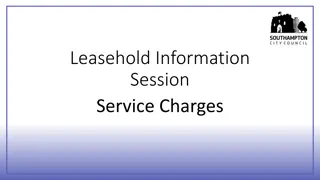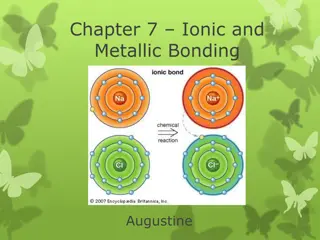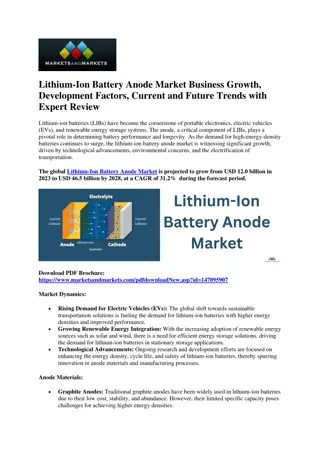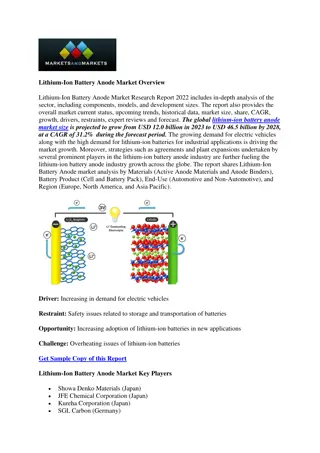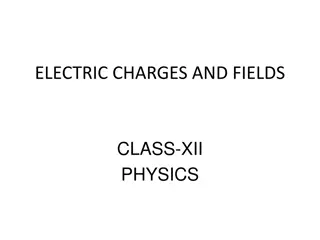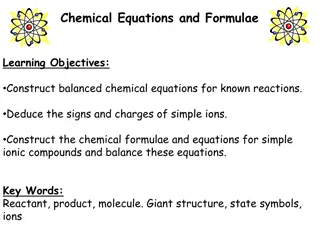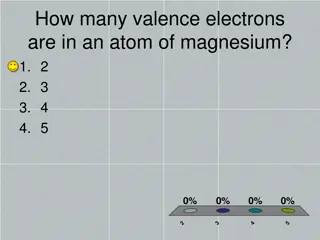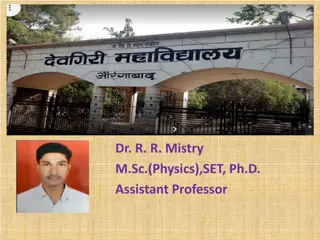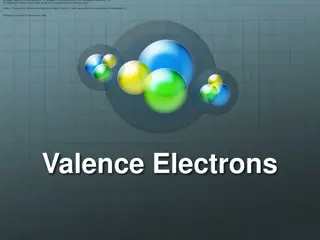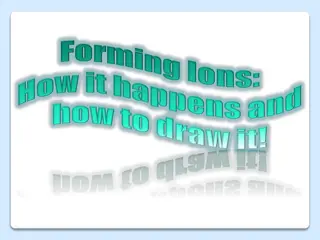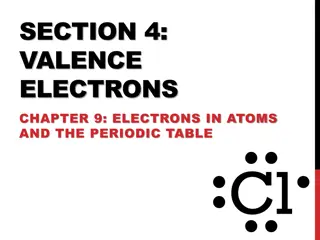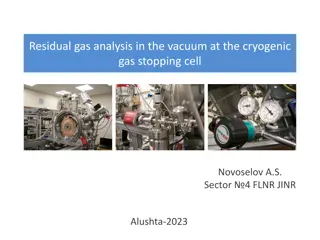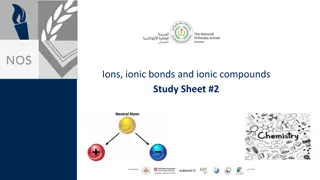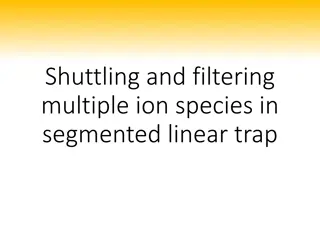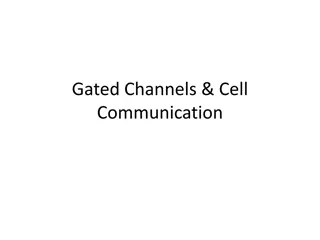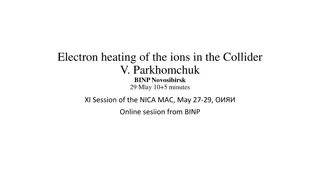Chemical Ion Formation: Electrons and Charges
The concept of ion formation through electron transfer between atoms, leading to the creation of cations and anions. Understand the relationship between ion charge, valence electrons, and chemical stability in compounds.
Download Presentation

Please find below an Image/Link to download the presentation.
The content on the website is provided AS IS for your information and personal use only. It may not be sold, licensed, or shared on other websites without obtaining consent from the author.If you encounter any issues during the download, it is possible that the publisher has removed the file from their server.
You are allowed to download the files provided on this website for personal or commercial use, subject to the condition that they are used lawfully. All files are the property of their respective owners.
The content on the website is provided AS IS for your information and personal use only. It may not be sold, licensed, or shared on other websites without obtaining consent from the author.
E N D
Presentation Transcript
After Specht: The Affirmative Act Requirement Richard Warner rwarner@kentlaw.iit.edu rwarner46@gmail.com
Offer and Acceptance Variations There was actual notice of the terms There was no actual notice of the terms Relevant custom and practice exits The bully Lefkowitz Capital One No relevant custom and practice Invoked Not invoked No term requires actual notice ProCD ProCD examples Most websites Specht Newspaper giveaway Note on the door
Terminology Clickwrap = affirmative act of consent like checking a box, clicking a button. Click here to agree Cannot continue if you do not click. Browsewrap = just a hyperlink, act of consent is just use of the site.
Nguyen v. Barnes & Noble This is a browsewrap case like Specht. Barnes & Noble offered discontinued HP Touchpads at a greatly reduced price. Nguyen purchased two units on Barnes & Noble s website on August 21, 2011, and received an email confirming the transaction. The following day, Nguyen received another email informing him that his order had been cancelled due to unexpectedly high demand.
The Dispute Nguyen: did not have notice of terms, and so did not assent to them. Barnes & Noble: The offer: presentation via the hyperlink is constructive notice [= should know of the terms], The acceptance: the notice plus the use of the website is acceptance of the terms.
The Courts Argument There is an offer only if there is actual notice or constructive notice of the terms. There was no actual notice. Was there constructive notice?
Hyperlink Not Enough For Notice The court s claim: Where the link to a website s terms of use is buried at the bottom of the page or tucked away in obscure corners of the website where users are unlikely to see it, courts have refused to enforce the browsewrap agreement. Is this true?
The Precedents For Unlikely To See It Specht v. Netscape: The court noted that the presentation made users think there were no contractual terms. Van Tassell v. United Marketing Group: The court held the contract was not enforceable because it was only accessible by process of multi-step clicking non-obvious links. That does mean the contract is unlikely to be seen. But why does that matter? Why is that a reason not to enforce the contract?
Offer and Acceptance Variations There was actual notice of the terms There was no actual notice of the terms Relevant custom and practice exits The bully Lefkowitz Capital One No relevant custom and practice Invoked Not invoked No term requires actual notice Specht Newspaper giveaway Van Tassel? ProCD ProCD examples Most websites Note on the door
Does Not Seeing Matter? Why does it matter that the user is not likely to see the link? Zeidenberg could not see the contract. Esterbrook s other examples insurance, concert tickets. Custom and practice creates constructive notice in these cases. Nguyen was decided in 2014. What reasonable web user in 2014 is unaware that there are contractual terms accessible via a hyperlink?
Courts Rejection of Custom and Practice Barnes & Noble s argument that Nguyen s familiarity with other websites governed by similar browsewrap terms, including his personal website <www. kevinkhoa.com>, gives rise to an inference of constructive notice is also of no moment. Whether Nguyen has experience with the browsewrap agreements found on other websites such as Facebook, LinkedIn, MySpace, or Twitter, has no bearing on whether he had constructive notice of Barnes & Noble s Terms of Use. The court gives NO argument for this.
Even More Puzzling We hold that where a website makes its terms of use available via a conspicuous hyperlink on every page of the website but otherwise provides no notice to users nor prompts them to take any affirmative action to demonstrate assent, even close proximity of the hyperlink to relevant buttons users must click on without more is insufficient to give rise to constructive notice.
What Is The Problem? Custom and practice not invoked? Much of what the court says fits with this. But it is very difficult to see why the custom and practice is not invoked. Why in most website cases, but not here? Key term requires actual notice? Without notice, no bargain adequately defined.
What Is a Key Term? A term that would significantly affects a party s reasonable expectations about contractual performance if the party had actual notice of the term.
Offer and Acceptance Variations There was actual notice of the terms There was no actual notice of the terms Relevant custom and practice exits The bully Lefkowitz Capital One No relevant custom and practice Invoked Not invoked No term requires actual notice Key term requires actual notice ProCD ProCD examples Most websites Nguyen? Klar Specht Newspaper giveaway Van Tassel Note on the door
Offer and Acceptance Variations There was actual notice of the terms There was no actual notice of the terms Relevant custom and practice exits The bully Lefkowitz Capital One No relevant custom and practice Invoked Not invoked No term requires actual notice Key term requires actual notice ProCD ProCD examples Most websites Nguyen Klar Specht Newspaper giveaway Note on the door
Why No Changes in the Site? Consumer breach of contract suits are rare. Cost/benefit analysis shows not worth changing. Not all courts agree. Prefer to keep the old practice, not start a new one. Lack of communication between lawyers, C-level officers, and IT people.
Daniel Berman v. Freedom Financial Network www.getsamplesonlinennow.com offered free samples. It said on its home page, Getting Free Stuff Has Never Been Easier!. The website collected personal data about visitors. The only indication that it was doing so was two hyperlinks presented by were two lines of text in a tiny gray font, which stated: I understand and agree to the Terms & Conditions which includes mandatory arbitration and Privacy Policy.
The Basis of the Lawsuit The information was used in telemarketing campaign on behalf of defendants Freedom Financial Network [to place] unsolicited telephone calls and text messages to hundreds of thousands of consumers . . . marketing Freedom s debt-relief services. The lawsuit is a class action on behalf of consumers who received unwanted calls or text messages from defendants during the telemarketing campaign conducted on Freedom s behalf. They allege that the calls and text messages were made or sent without their consent and therefore violated the Telephone Consumer Protection Act (TCPA), 47 U.S.C. 227 et seq.
The Issue Before the Court The issue before the court is whether to order the case to arbitration in accord with the terms of use agreement. They will do so but only if that agreement is enforceable. They hold it is not enforceable on the ground that website visitors did not have constructive notice that they were being invited to enter a contractual relationship. That is: a reasonable person in the circumstances would NOT be on notice that they were being invited to enter a contractual relationship under the terms in the agreement.
Why Does The Court Hold That? The court: Unless the website operator can show that a consumer has actual knowledge of the agreement, an enforceable contract will be found based on an inquiry notice theory only if: (1) the website provides reasonably conspicuous notice of the terms to which the consumer will be bound; and (2) the consumer takes some action, such as clicking a button or checking a box, that unambiguously manifests his or her assent to those terms.
A Lack of Notice Rationale The requirements of conspicuous notice and affirmative action of assent are the court s response to the fact what it supposes is a fact that otherwise a reasonable person in the circumstances would NOT be on notice that they were being invited to enter a contractual relationship. Why?
Offer and Acceptance Variations There was actual notice of the terms There was no actual notice of the terms Relevant custom and practice exits The bully Lefkowitz Capital One No relevant custom and practice Invoked Not invoked No term requires actual notice Key term requires actual notice ProCD ProCD examples Most websites Nguyen Berman Klar Specht Newspaper giveaway Van Tassel Note on the door
What Counts As Conspicuous? Then the court tries to give general rules for all online contracts. The notice must be displayed in a font size and format such that the court can fairly assume that a reasonably prudent Internet user would have seen it. The design of the hyperlinks must put such a user on notice of their existence.
Unambiguous Manifestation of Assent The court: A user s click of a button can be construed as an unambiguous manifestation of assent only if the user is explicitly advised that the act of clicking will constitute assent to the terms and conditions of an agreement. But this just raises another question, what counts as explicit advice ? What is notenough: just a textual notice (like subject to these terms of use ) close to the hyperlink to the terms.
Indicating What Counts As Assent You must also indicate what counts as assent to the terms. The court: the website did not indicate to the user what action would constitute assent to those terms and conditions. Likewise, the text of the button itself gave no indication that it would bind plaintiffs to a set of terms and conditions. This notice defect could easily have been remedied by including language such as, By clicking the Continue >> button, you agree to the Terms & Conditions.
A Puzzle This does not meet the requirements of conspicuousness and affirmative assent. But it is the almost universal practice.
Moretti v. The Hertz Corporation This is a clickwrap case. The underlying dispute was about a pattern of overcharging by Hertz. The case concerns the Moretti s consent to the forum selection clause in the Hertz online agreement. There was an Acceptance Box and you could not reserve a car without checking it. For this reason, the court concluded he had notice and consented to the Terms of Use containing the forum-selection clause.
Compare EU Cookie Notices The EU requires the conspicuous notice of the use of cookies. How many times have you refused to visit a site because of that notice? Later, we will make the same point about the GDPR.


